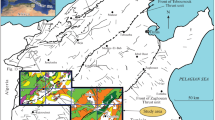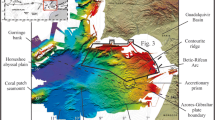Abstract
The present-day denudation scarps on the Russian Plain, many hundred kilometers in extent, resemble faults. The kinematics of low-amplitude displacements deduced from their configuration and mesotectonic measurements corresponds to the recent regional stress regime transmitted in the lateral direction to the platform basement via consolidated crust from the zone of Alpine collision. At the same time, no high-amplitude regional faults are known near the scarps. This paradox can be resolved assuming that the scarps are formed by tightening of low-amplitude stress-release joints rather than along extended faults. The zones of such joints mark the belts of stresses in the platform basement induced by collision. Since the erosion that forms a scarp relaxes residual tectonic stresses, a river’s bank is not destroyed chaotically, so that particular segments of scarp follow paths of the regional stress field. Thus, the configuration of banks, in combination with other structural features, makes its possible to forecast the character of recent collision-related stresses transmitted from a depth.
Similar content being viewed by others
References
V. I. Babak and N. I. Nikolaev, Explanatory Notes to the Map of Geomorphic-Neotectonic Regionalization of the Non-Chernozem Zone of the RSFSR on a Scale of 1: 1500000 (VIEMS, Moscow, 1983) [in Russian].
S. S. Voskresensky, “Asymmetry of River Valley Slopes in the European Part of the USSR,” in Problems of Geography (1947), No. 4, pp. 107–114 [in Russian].
M. V. Gzovsky, Principles of Tectonophysics (Nauka, Moscow, 1975) [in Russian].
V. G. Kaz’min and A. F. Byakov, “Continental Rifts: The Structural Control of Magmatism and Continental Breakup,” 31(1), 20–31 (1997) [Geotectonics 31 (1), 16–26 (1997)].
The Map of Neotectonics of the Middle and Lower Volga Region, Ed. by F. I. Koval’sky (Nizhnevolzhskgeologiya, Saratov, 1981) [in Russian].
E. G. Kachugin, “One More Cause of river Valley Asymmetry,” in Problems of Geography (1950), No. 4, pp. 89–98 [in Russian].
M. L. Kopp, Structures of Lateral Extrusion in the Alpine-Himalayan Collision Belt (Nauchnyi Mir, Moscow, 1997) [in Russian].
M. L. Kopp, Mobilistic Neotectonics of Platforms in Southeast Europe (Nauka, Moscow, 2004) [in Russian].
M. L. Kopp, “Recent Deformation of the Southern Urals and the Mugodzhary Mountains and Its Possible Origin,” Geotektonika 39(5), 36–61 (2005) [Geotectonics 39 (5), 364–388 (2005)].
M. L. Kopp, E. Yu. Egorov, and A. A. Zarshchikov, “On Origin of the Volga-Yergeni Scarp,” Izv. Vyssh. Uchebn. Zaved., Geol. Razv., No. 4, 21–37 (1999).
M. L. Kopp, A. I. Ioffe, E. Yu. Egorov, et al., “Geodynamics of the Oka-Don Recent Trough,” in General and Regional Issues of Geology. Formation Dynamics, Structure, Composition, and Mineral Resources of Fold Systems and Sedimentary Basins of Various Geodynamic Settings. Federal Target Program “Integration.” Project A.0070 (GEOS, Moscow, 2000), No. 5, pp. 123–179 [in Russian].
M. L. Kopp, A. A. Nikonov, and E. Yu. Egorov, “Kinematics of the Recent Structure and Seismicity of the Miocene-Quaternary Oka-Don Trough,” Dokl. Akad. Nauk 385(3), 387–392 (2002) [Dokl. Earth Sci. 385A (6), 623–628 (2002)].
Yu. G. Leonov, O. I. Gushchenko, M. L. Kopp, and L. M. Rastsvetaev, “Relationship between the Late Cenozoic Stresses and Deformations in the Caucasian Sector of the Alpine Belt and Its Northern Foreland,” Geotektonika 35(1), 36–59 (2001) [Geotectonics 35 (1), 30–50 (2001)].
V. I. Makarov, “Quaternary Tectonics and Geodynamics of Platform Territories: Topical Problems,” Byul. Kom. po Izucheniyu Chetvertichnogo Perioda, No. 68, 10–25 (2008).
Miocene of the Oka-Don Plain (Nedra, Moscow, 1977) [in Russian].
Neotectonics and Geodynamics: Zone of Conjugation of the East European Platform and the Scythian Plate, Ed. by Yu. K. Shchukin (Nauka, Moscow, 2006) [in Russian].
G. V. Obedientova, Formation of Drainage System of the Russian Plain (Nedra, Moscow, 1975) [in Russian].
R. A. Orlov, L. I. Nadezhka, and I. N. Safronich, “Ratio of Average Modules of Microseismic Noise Amplitude Applied to the Geological Study of Platform Territories, the Case of Voronezh Massif,” in Proceedings of V All-Russia Conference (Inst. Geoenvironmental Problems of the North, Arkhangel’sk Sci. Center, Arkhangel’sk, 2009), pp. 345–349 [in Russian].
M. L. Kopp, K. I. Kuznetsova, Yu. G. Leonov, and E. V. Sharkov, Geology of Syria (Nauka, Moscow, 2000) [in Russian].
G. I. Raskatov, Geomorphology and Neotectonics of the Voronezh Anteclise (Voronezh State Univ., Voronezh, 1969) [in Russian].
A. P. Rozhdestvensky, “Relationships of Some Meanders of the Volga River with Local Tectonics,” Dokl. Akad. Nauk SSSR 90(3), 457–459 (1953).
A. P. Tarkov, V. P. Patsev, and K. Yu. Silkin, “Structural Disharmony of Sedimentary Cover of the Voronezh Anteclise from Micro-CDP Seismic Profiling,” Geofizika, No. 1, 68–70 (2002).
Glossary of Geology, the Fourth Edition (Amer. Geol. Inst., Alexandria, 1997) [Glossary of English Geological Terms, Ed. by N. V. Mezhelovsky (Geokart, Moscow, 2002), Vols. 1, 2)].
A. I. Tregub, Neotectonics of the Voronezh Crystalline Massif (Voronezh State Univ., Voronezh, 2002) [in Russian].
V. M. Kharchenko, Candidate’s Dissertation in Geology and Mineralogy (Moscow, 1982).
N. S. Shatsky, “The Balyklei Graben and Dislocations of the South Volga Region,” Vestn. Mosk. Gorn. Akad., 1(1), 13–43 (1922).
G. Mandl, Rock Joints: the Mechanical Genesis (Springer, Geidelberg, 2005).
A. M. Nikishin, M.-F. Brunet, S. Cloetingh, and A. V. Ershov, “Northern Peri-Tethyan Cenozoic Intraplate Deformation: Influence of the Tethyan Collisional Belt on the Eurasian Continent from Paris to Tien-Shan,” C. R. Acad. Sci., Ser. IIa 329, 49–57 (1999).
B. R. Rosendahl, “Architecture of Continental Rifts with Special Reference to East Africa,” Ann. Rev. Earth Planet. Sci. 15, 445–503 (1987).
Author information
Authors and Affiliations
Corresponding author
Additional information
Original Russian Text © M.L. Kopp, 2011, published in Geotektonika, 2011, Vol. 45, No. 5, pp. 71–90.
Rights and permissions
About this article
Cite this article
Kopp, M.L. Denudation scarps as indicators of regional tectonic stresses. Geotecton. 45, 394–410 (2011). https://doi.org/10.1134/S0016852111040029
Received:
Published:
Issue Date:
DOI: https://doi.org/10.1134/S0016852111040029




